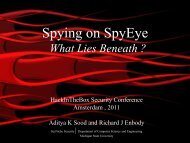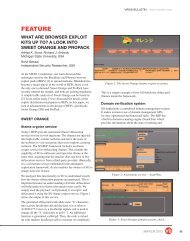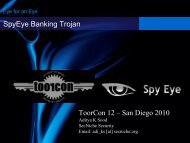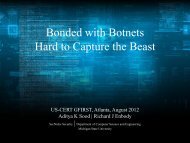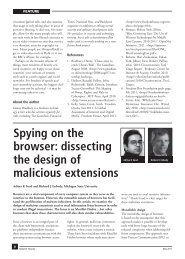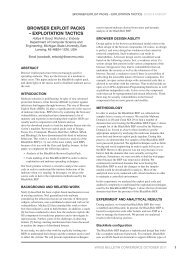Dissecting Java Server Faces for Penetration Testing - SecNiche ...
Dissecting Java Server Faces for Penetration Testing - SecNiche ...
Dissecting Java Server Faces for Penetration Testing - SecNiche ...
- No tags were found...
Create successful ePaper yourself
Turn your PDF publications into a flip-book with our unique Google optimized e-Paper software.
4.4.1 Secure Way of Configuring Security DescriptorsThe best practice is to declare the configuration parameters in web.xml as presentedin listing 5.javax . f a c e s .STATE SAVING METHODc l i e n t org . apache . myfaces . s e c r e t MDEyMzQ1Njc4OTAxMjM0NTY3ODkwMTIzorg . apache . myfaces . algorithm AESorg . apache . myfaces . a l g o r i t h m . parameters CBC/PKCS5Paddingorg . apache . myfaces . a l g o r i t h m . iv NzY1NDMyMTA3NjU0MzIxMA==org . apache . myfaces . s e c r e t . cache false Listing 5: Secure Way of Declaring Encryption Parameters in JSFThis point should be taken into account while doing penetration testing so thatenhanced attacks can be tested against the inappropriate implementation ofJSF security.NOTE: It has been noticed that JSF framework only encrypts ViewState inorder to provide confidentiality but there is no standard implementation of MACby default so that the integrity of ViewState is preserved. While we know thatJSF security greatly depends on the web.xml file, the MAC functionality is alsointroduced in it. The developer has to explicitly specify the MAC algorithm,key and caching.The parameters that are used nowadays are ”org.apache.myfaces.MAC ALGORITHM”,”org.apache.myfaces.MAC SECRET” and ” org.apache.myfaces.MAC SECRET.CACHE”respectively. Always declare all of these parameters in lower case.15




